How to plant a pear in spring and autumn: timing and rules for planting a seedling
Almost everyone loves pears, but not everyone knows how to plant them correctly. This can be said about everything. Indeed, if you do not know the rules of planting, then not only the waiting period for the first harvest can noticeably increase, but the further development of the tree will slow down. By the way, its premature death may depend on the correct landing.
Well, then we will talk in detail about how to plant a pear correctly in spring or autumn, so that the tree takes root well in a new place and begins to actively grow and bear fruit abundantly in due time.
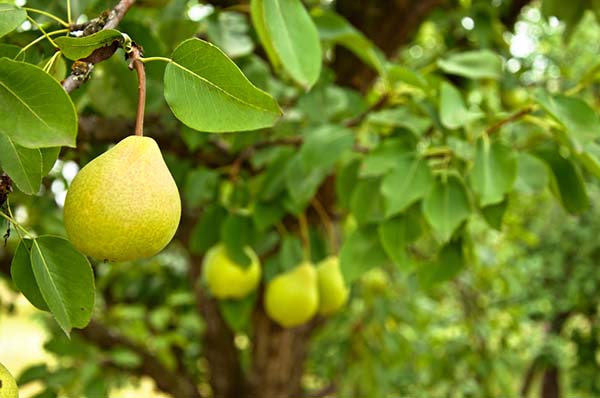
Content
When to plant a pear in spring and autumn: choosing the best time to plant
Of course, if you live in the South, then this (planting time) is not of fundamental importance (unless it is worth planting in the summer in extreme heat). It is another matter if you are a gardener of the Middle Lane (Moscow region), or even more so the Urals or Siberia. Then it's worth weighing up the pros and cons!
Interesting! There is even an opinion that in the southern regions it is better to plant all crops in the fall, and in the northern ones only in the spring.
Video: in what time frame is it better to plant seedlings of fruit and berry crops
The optimal timing for planting pears in spring and autumn
So, earlier we found out that, depending on the climatic characteristics of the region, pear seedlings can be planted all year round - from April to October, unless it is recommended to do this in the middle of summer, when it is very hot (especially in the South!).
Further, we are already talking about the choice of more specific dates for planting pears in autumn and spring in different regions.
By the way! The best time to plant seedlings is cloudy and calm weather, early morning or late evening.
Spring planting
If you want to plant a pear in spring, then you need to have time to do it more before budding on the seedling (beginning of sap flow), in other words, before it enters the growing season (i.e. the plant must still sleep).
Another important condition for a successful spring planting of pears is the establishment positive air temperature, and not only during the day (it should already be +5), but also at night.
Advice! Don't wait for the ground to completely thaw out. It is very good to plant seedlings with an open root system (this way they take root better) immediately after the snow melts, when the ground is still wet.
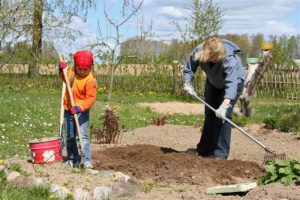
As for the approximate dates, they depend on the climatic characteristics of the region. So, the spring planting of pears is recommended from late March-April to early-mid May:
- In the South of Russia, pear seedlings can be planted in open ground already in the second half of March and early April.
- In the Middle Polos (Moscow region), a pear is planted not earlier than the second half of April.
- In Siberia and the Urals - only in late April and early May.
Autumn planting
If you decide to plant a pear in the fall, then the most important thing is to determine when stable frosts will come and plant it 3-4 weeks before their onset. This time is just enough for the seedlings to take root well and go into winter, settling down in a new place.
Thus, depending on the climatic characteristics of the region, the autumn planting of pears is recommended from September to the end of October:
- So, in the South of Russia, a pear can be planted until late autumn - until the end of October.
- Gardeners of the Middle Strip (Moscow Region) need to have time to plant pears in autumn before the end of September (maximum - in early October).
- In colder regions - in the North-West (in the Leningrad region), as well as in Siberia and the Urals, planting is carried out in early autumn - in the first half of September.
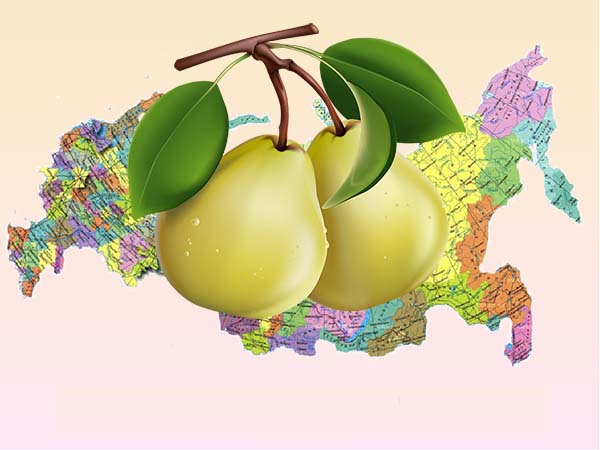
How to keep seedlings until spring
Too late to plant seedlings in the autumn is also not recommended, because shoots must have time to mature well in order to successfully survive the winter.
This is especially true for planting pears in cold (northern) regions, in the same Siberia.
Therefore, if you are late, and frosts are expected within 1-2 weeks, then it is better to play it safe and postpone the planting of pears until spring.
You can save the seedling by digging it in the garden or by planting it in a container and putting it in the basement or cellar, where the temperature is kept around + 1 ... + 4 degrees.
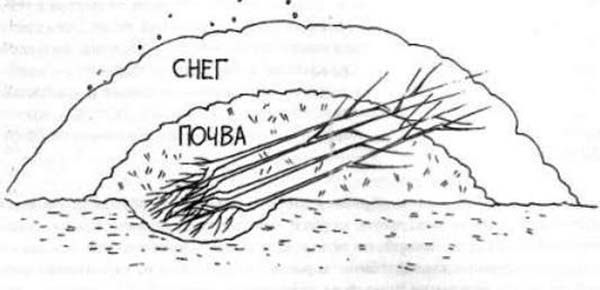
According to the lunar calendar in 2020
Choose the optimal date for planting seedlings of fruit trees can help you moon calendar.
So, favorable days for planting pears in spring and autumn in 2020, according to the lunar calendar, are:
- in March - 26-29;
- in April - 11-15, 24, 25;
- in May - 2-10;
- in September - 19-26;
- in October - 3-13, 18-21.
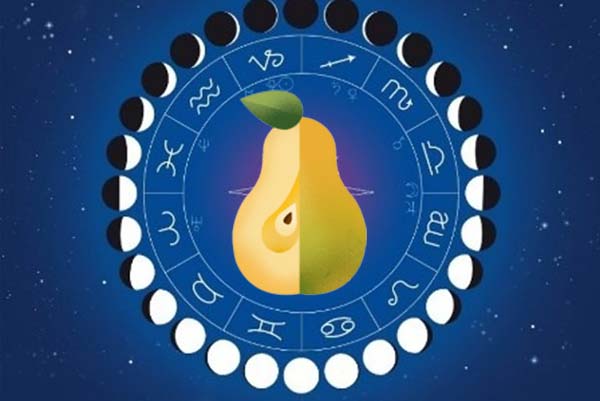
Of course, it is not always possible to get to the dacha on the right dates, so the main thing is not to land on unfavorable dates according to the lunar calendar - the days of the New Moon and Full Moon, as well as the period when the Moon is in Aquarius, because it is a barren and dry sign -in italics.
Unfavorable days, according to the lunar calendar for 2020, for planting pear seedlings are the following dates:
- in March - 9,19-21, 24;
- in April - 8,15-17, 23;
- in May - 7,13-14, 22;
- in June - 5,9-11, 21;
- in July - 5,7-8, 20;
- in August -3, 4-5, 19, 31;
- in September -1, 2, 17, 27-28.
- in October - 2, 16,24-26, 31
- in November - 15,20-22, 30.
According to the lunar calendar, from the magazine "1000 Tips for Summer Residents".
How to properly plant a pear in open ground
Let us analyze in stages all the main points concerning planting a pear, starting with the choice of a seedling and before its direct planting in the planting pit.
What should be a seedling
When choosing a planting material (a specific variety), first of all, you need to pay attention to its origin. Optimal to buy local zoned varieties pears that are best suited for growing in your climate, i.e. adapted to weather conditions and the soil composition of your growing region.
Interesting! Previously, it was believed that winter hardiness is one of the most important criteria when choosing a pear variety, however, now varieties have been bred whose winter hardiness is higher than that of apple trees.
As for the seedlings, they can be either with an open root system (OCS) or with a closed one (in a container).
It is better for novice gardeners to buy seedlings with ZKS (closed root system), and experienced ones can also purchase with ACS.
A good pear seedling should have the following qualitative and quantitative characteristics:
- Healthy general appearance without signs of wilting, damage by diseases or pests.
- Age no more than 2 years (i.e. it is a one-year or two-year-old), since at this age the seedlings adapt faster to a new place.
- Height within 1-1.5 m: Any deviation up or down indicates improper care.
Another thing is that some sellers immediately sell cut seedlings, but this is rare.
- Xwell-developed root system (without any growths and neoplasms), that is, in addition to the main root, there should be several more lateral roots (the older the seedling, the more roots it has) about 20-25 cm long, while they should not be overdried and broken ...
By the way! Even if you are buying a seedling with a closed root system, you may want to consider lateral roots because they tend to stick out of the container.
Advice! And to check whether it is really a seedling with a closed root system, you need to take it by the trunk and shake it. If it sits tightly, everything is fine, if not, then something is wrong here ... the seller wants to earn more money by slipping you a seedling with ACS, which he transplanted into a container a couple of days ago.
- At the bottom, on the trunk, you should clearly see vaccination site (connection of rootstock and scion), which will guarantee that this is a varietal tree, and not wild.
As a rule, the vaccination is done by budding method (they also say "grafted with an eye"), less often with a handle (ie copulation).
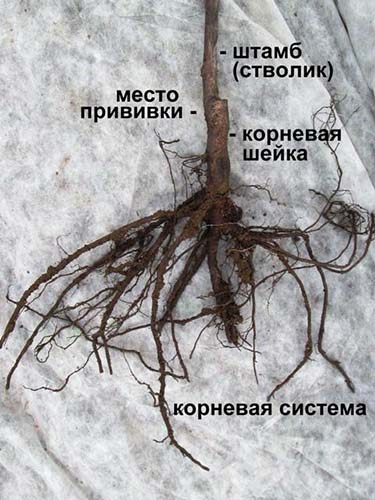
- It is also worth evaluating the quality of the upper part of the trunk (grafted part): the wood must be ripe and strong, without any mechanical damage, sunburn, frost cracks and cracks in the bark. Himself the trunk must be straight and not bent.
Note! If the bark on the trunk peels off in places without damaging its integrity, then this is a sign of improper storage of the seedling in winter, which led to its freezing.
- It is highly desirable that the seedling did not show any signs of the beginning of the growing season, i.e. was at rest. This means that its buds should still be sleeping (i.e. there should be no leaves on it).
Important! The above criterion concerns the selection and purchase of a seedling in the early spring period, but some agronomists also advise purchasing seedlings without leaves in the fall or harvesting them yourself.
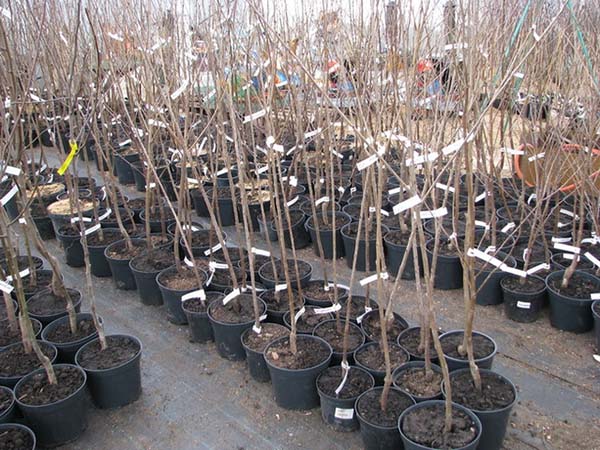
However, seedlings with a closed root system (in containers) in the spring are often sold already in the growing season, which is quite normal. Therefore, in this case, you also need to carefully evaluate their appearance, especially the color of the leaves.
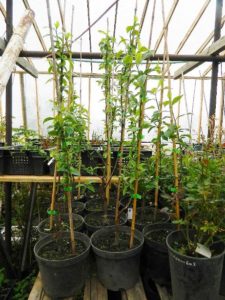
Preparing for landing
Immediately before planting, the roots of the seedling should be washed from the old soil. Then dip it in a clay mash, and then renew the tips of the roots, cutting them slightly. This is all the more necessary if they are too long, or you notice that there are damaged, sore and broken roots (to a healthy place).
Some gardeners recommend completely soaking the seedling in water (you can add Kornevin) for a day or at least an hour and a half, which will help restore biological processes in the roots and saturate them with moisture. Moreover, this is especially necessary if you see that the roots are slightly dry (This should not be allowed under any circumstances!).
Landing place
The pear is considered a more thermophilic crop than the apple treeso you should find sunniest place on your site.
Accordingly, for planting pears suitable South side (or at least southwestern), while on the north side the tree will be protected from the drying winter winds (this can be your country house, some kind of outbuilding or fence).
Note! If the place is dark and cold, then the pears will stretch out shoots, trying to reach the sun's rays. Naturally, fruiting will be delayed.
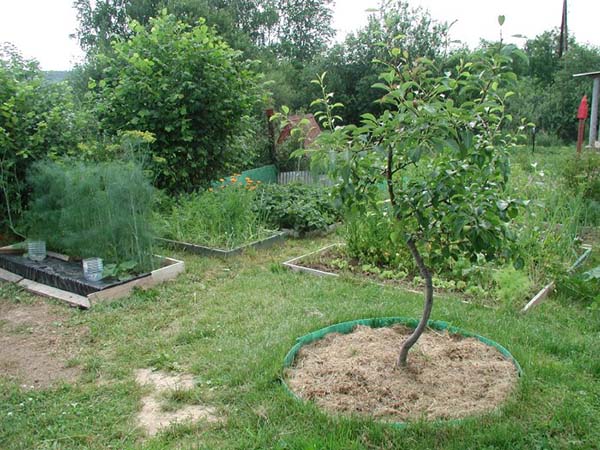
When planting pears, be sure to consider groundwater occurrence: they should be located not closer than 1.5-2 meters to the soil surface.
If the groundwater in your area is closer than 1.5 meters, then you have no choice but to do it. artificial hill and plant a seedling already on it.
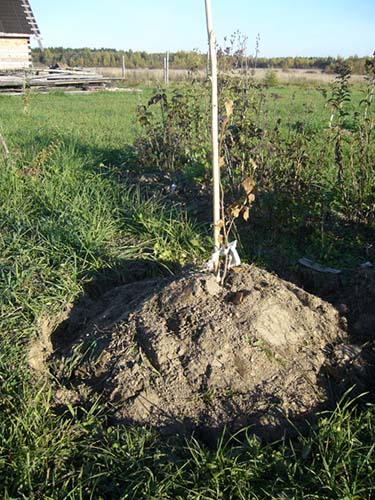
Also, you should not plant a pear. in the lowlandswhere for a long time melt water stagnates. In other words, at the landing site moisture should not stagnate in the springwhen the snow melts. Otherwise, the plant will simply underpin the root collar and your pear tree will die.
Important! In no case should you choose a place near large spreading trees for planting pears (especially nut), since this will necessarily have a bad effect on its growth and yield (if the seedling can generally take root normally and begin to bear fruit).
At what distance to plant
We figured out the place, now you need to decide on the scheme for planting pears on the site.
As a rule, it is recommended to plant pears according to the scheme - 3 by 3, i.e. the distance between seedlings in a row and between rows should be 3 meters.
Important! Do not forget to step back from the fence at least 2 meters.
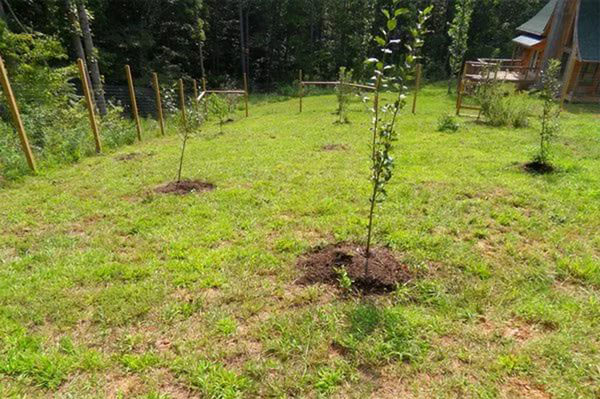
Remember! The closer you plant trees, the more difficult it will be for you to control their crown in the future - you will need regular and mandatory pruning, including summer pruning.
Some varieties of pears (the same Moskvichka) - self-infertile, i.e. nearby you need to plant other pollinating varieties (for example, Yakovleva's Lyubimitsa or Moskovsky Bergamot), which have the same flowering and ripening periods.
Required soil
Where will any fruit tree grow and bear fruit well? That's right, on fertile land, i.e. light and loose (water and breathable), and also with neutral acidity level (maximum with slightly acidic reaction).
Thus, the most suitable soil types for planting and growing pears are loams. It will also grow well on sandy loam soil and light black soil.
Important!If the soil on your site is excessively clay or sandy, then in the first case you will need to add more sand and compost to the planting hole, and in the second - a little clay and more compost (or non-acidic peat).
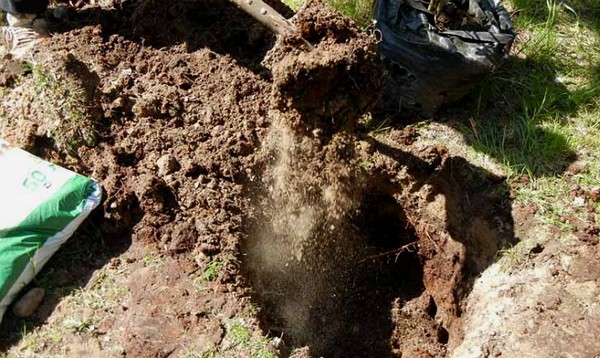
Advice! In a cold and harsh climate, as well as if your land is very heavy (solid clay), or the site is very waterlogged and the groundwater is very close, it is recommended to plant pears on gentle hills (they also say "according to Zhelezov").
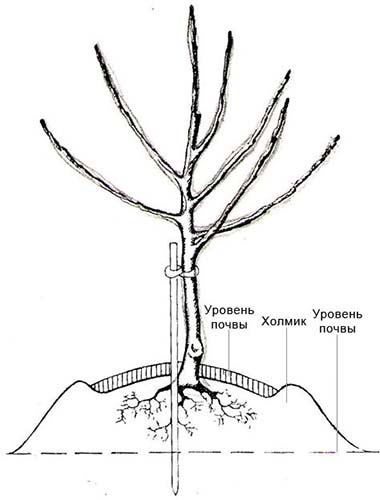
Planting pit preparation: optimal dimensions
A planting pit for planting a pear seedling or any other plant is recommended prepare in advance... It is best to do this one season or at least 1-2 weeks before planting the seedling, so that the soil has time to settle to the desired level.
Advice! When digging a planting hole, it is very important to maintain the upper fertile soil layer. You will still need it!
Width (diameter) and depth of the planting pit for all fruit trees must be within 50-80 cm (usually, on average they dig a hole 60 by 60 cm). In this case, the walls of the recess should not taper downward: it is better to make them vertical.
By the way! It is more practical to dig a hole that is shallower, but wide enough, for example, 50-60 cm deep and 70-80 wide.
However, if you have to plant into clay soil, then besides obligatory drainage layer, you still need to dig and deepest pit.
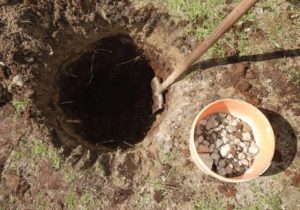
And here is the planting hole for planting a seedling closed root do just 2-3 times larger than the container itself.
If necessary, it is immediately laid on the bottom drainage layer 5-15 cm from broken brick or small stones (it is optimal to use lime or chalk crushed stone, in which there is a lot of calcium and which perfectly deoxidizes the soil = lowers its acidity), and already then the prepared nutrient mixture is poured (more on this later in a separate paragraph).
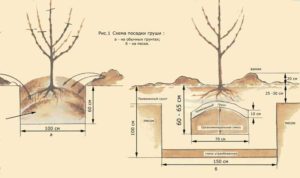
How to fill the planting hole - we prepare a nutritious substrate
For a quick start and better survival of the seedling in a new place, it is recommended to pour a specially prepared soil mixture into the planting hole (which must be thoroughly mixed to a uniform consistency).
Such a nutritious substrate can be prepared from the following components (mineral and organic fertilizers) by taking:
- riding fertile soil (upper 20-30 cm), which you put aside when digging a hole;
- a bucket (8-9 kg) of good humus or compost;
Additionally:
- a bucket (8-9 kg) of non-acidic peat (if desired and possible, as well as in case you have excessively sandy soil);
- a bucket (8-9 kg) of sand (if you have relatively heavy / clay soil);
- 1-2 cups (200-500 grams) superphosphate or 400-600 grams of bone meal (organic phosphorus fertilizer);
- half or 1 cup of potassium sulfate (100-200 grams) or 2-4 cups (200-400 grams) wood ash (organic analogue of potash fertilizer).
Advice! Instead of superphosphate and potassium sulfate, during spring planting, you can use nitroammophoska (16% nitrogen, phosphorus and potassium each) - 300-400 grams, and for autumn planting - diammophoska (10:26:26).
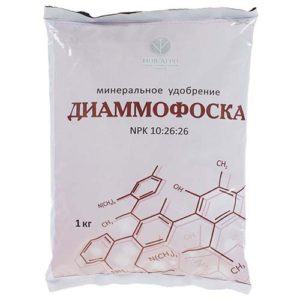
Worth knowing! When planting a tree (even in spring), it is not necessary to specially add nitrogen fertilizers (another thing if it is a complex fertilizer), since they stimulate the growth of the aboveground part to the detriment of the development of the root system (especially when planting in northern regions).
However, some gardeners do not recommend laying mineral fertilizers in the planting pit, but advise them to be applied in the future as top dressing. It is believed that the plant (seedling) does not need fertilizer until it begins to bear fruit. On the other hand, this does not apply to organic fertilizers (compost, bone meal, wood ash) - it is recommended to make them.
Advice! After filling the pit with a nutrient substrate, do not forget in the middle drive in a wooden peg, which will further serve as a support for a young seedling.
Why is this necessary?
If you do not tie a young seedling to a support, then when leaves grow on it, due to its high windage, strong winds will sway the trunk and cut off young roots.
Video: planting a pear
Algorithm for direct landing procedure
Step-by-step instructions for autumn or spring planting of a pear seedling in open ground:
- Prepare and fill the planting hole with fertile soil in advance, leaving a depression for the size of the seedling root system.
Further, if desired, you can slightly spill a hole filled with nutrient soil with water.
The fact is that many water only after planting, others - both before and after, in other words, everyone does it differently.
- If you are planting a seedling with an open root system (ACS), then you need to put a small mound in the center of the planting hole (so to speak, make a root pillow).
If you are planting a seedling with a closed root system (ZKS), then you do not need to make any mounds, but simply plant the seedling in a prepared planting hole without disturbing the earthen coma.
- Drive in a wooden support or a peg (but it is better to do this in advance).
- Place the seedling in the center and spread the roots along the sides of the mound straight down (The roots should never bend and stick up!).
Important! If you have a seedling, grafted with an eye (budding), then the budding site (eye = new shoot that grew from the grafting) should face north and the cut site should face south.
- Cover with earth (top layer of soil), while periodically shaking the seedling to eliminate voids between the roots.
When planting, in no case should the root collar be buried, so it is advisable to initially place it slightly above the soil surface, and after the tree settles in loose soil, it should be flush with the soil or slightly lower.
Advice! It is convenient to control the landing level with a rail (or a shovel handle), which must be placed horizontally on the sides of the pit.
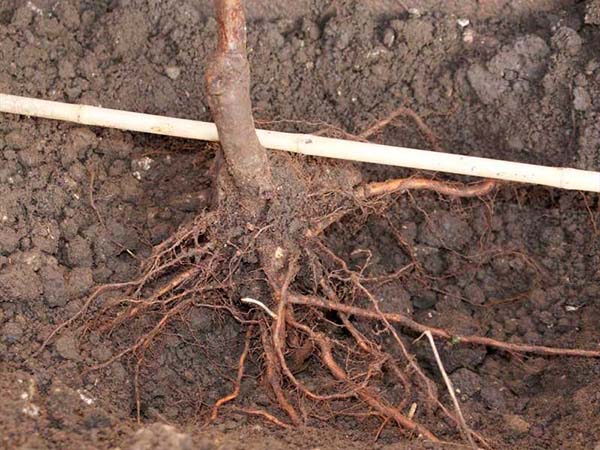
- Compact (compact) the soil.
Important! Do not confuse the root collar (the place where the first root originates from the trunk) with the grafting (grafting site), which is higher (on the stem) and as a result, as a rule, should be located 3-5 cm (you can just attach 2-3 fingers) higher soil surface.
However, according to the knip-baum system (technology for growing seedlings), the grafting site at the stock can be located at a height of 60 cm, and not 3-5 cm (with the usual method of growing and grafting seedlings).
In any case, decisive for landing is finding the root collar at ground level.
If you deepen the root collar, the tree will not grow well (and fruiting will be delayed), or it may even die (due to high humidity, the root collar itself will begin to weep). On the contrary, if you plant too high, the roots of the seedling will be exposed and may simply dry out in the summer heat or freeze in winter.
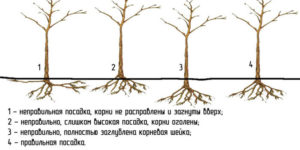
- Next, you need to make a hole (roller) along the diameter (perimeter) of the trunk circle 5-10 cm high.
- Spill abundantly with water, pouring out at least 2-3 buckets (pour out gradually - wait for it to be absorbed, and add more).
- Tie the seedling to the prepared support with a soft twine and secure in the correct position.
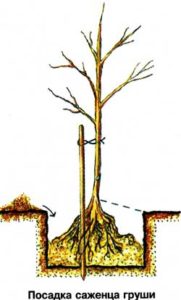
- Smooth out the roller, loosen the soil in the near-trunk circle and mulch it with peat, humus or compost (2-3 cm).
Mulch will help to avoid drying out of the roots and excessive evaporation of moisture.
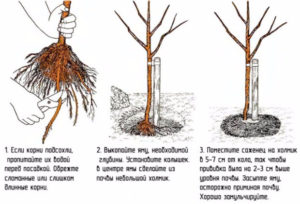
Note! Mulch should not be laid close to the trunk of the seedling, as this can cause the bark to undergo heating, and, consequently, cause the development of fungal diseases.
In any case, the grafting site should be above the mulch.
Video: planting and caring for a pear
How to care for a pear after planting in spring and autumn
Immediately after planting, a pear seedling is required pruneto level the root system with the aboveground part (this is done for a kind of "resuscitation" of the seedling after planting, since any planting and transplanting is an injury and serious stress for the plant).
By the way! The site also has detailed material on how how to properly cut and shape a young pear.
How to prune a pear after a spring or fall planting?
- You need to leave the main stem 50-60 cm high by cutting above the healthy kidney.
If there are side shoots on the main trunk, then they also need to be shortened, leaving 2 buds each.
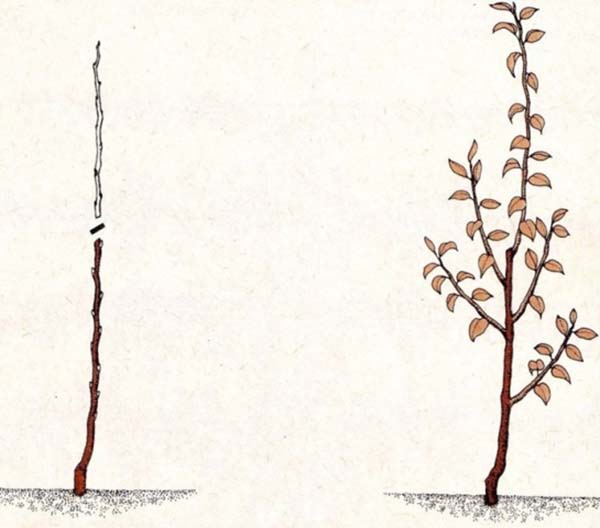
Further, a young tree will need from you careful post-planting care aimed at creating optimal conditions for its early survival in a new place (this is especially important if planting was made in spring).
One of the main conditions for a successful pear rooting is a sufficient amount of moisture in the soil. Therefore, if the weather is dry, then after planting, the seedling should be watered on time and regularly (1-2 times a week), pouring out 2-3 buckets of water. In the future, watering will need to be carried out as needed, depending on the weather conditions (in spring and autumn, you can water 2-3 times a month, and in the hot and dry summer period - once a week).
And after each watering, if you have not mulched the tree trunk circle, it is recommended loosen the soil at the baseto improve oxygen access to the roots. Don't forget that you also need weed the weeds off the trunk circle.
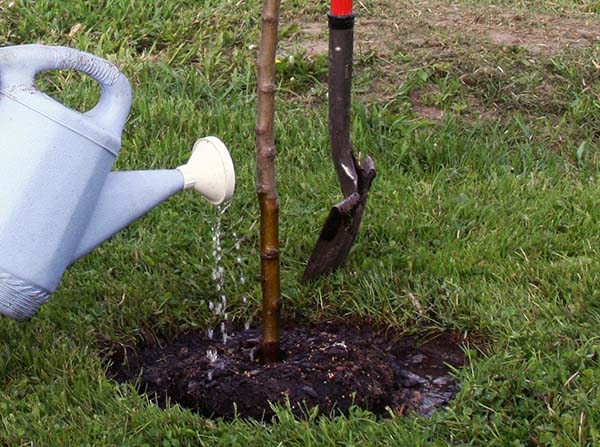
Advice! Either make a new hole every year, or initially dig not very deep (maximum - 3 cm) so that moisture does not accumulate in it in the winter-early spring period and the root collar does not get wet and melt away.
Additional dressings within the next 2-3 years it will not be required, since all the necessary nutrients were added during planting.
Note! But in the future, for the successful cultivation of pears, fertilizing the culture will be simply necessary.
About, how and what to feed in the spring and summer you can read here, a after fruiting (in autumn) — here (both articles are about fertilizing apple trees, but pears are fed in the same way).
Also, don't forget correctly prepare the pear for winter (which is very important for young seedlings).

Also, all fruit trees every fall need whitewash.
And if in the future you don't like the variety or want to have several different varieties on the same tree at the same time, You can plant a pear in one of the known ways.
Important! The site has a detailed article about when and how to plant a pear correctly.
Of course it is required closely monitor the condition of your treeso that he is not suddenly struck by any diseases, pests do not attack.
The most annoying fungal diseases that affect the pear are moniliosis or monilial rot (pears turn black and rot right on the tree) and scab... Pests also attack the pear. So if your pear trees attacked by aphids, then in the fight against the malicious pest of fruit trees you will help this material.
By the way! The site has detailed articles on how how to properly spray fruit trees (including pears) against diseases and pests in spring, and in the fall.
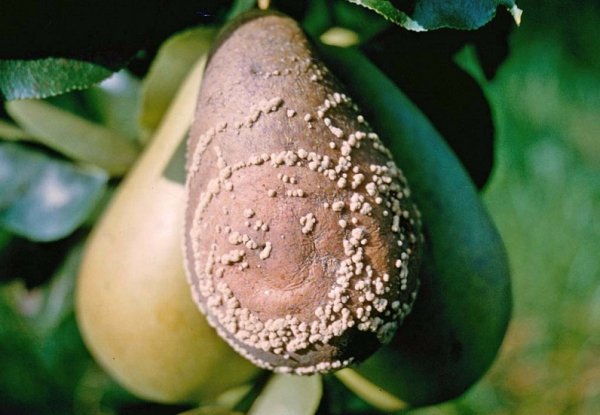
Video: how to grow a pear in the Middle Lane - agronomist advice
Plant a pear on your site according to all the listed and well-known rules and wait for the first harvest in 3-5 years. Good luck!
By the way! If the seedling for some reason does not survive the winter well and in the spring it has shoots below the grafting site, then it will already be wild. Such a pear will either have to be dug up and discarded, or re-grafted. If new shoots are formed above the grafting site, then these are varietal branches - everything is fine.
Video: how to plant a pear correctly

